Yesterday we discussed the management of aerosol cans in order to keep your workers safe. Today we will look at the difficult issue of disposing of aerosol cans.
Recycling Aerosol Cans
Under federal Resource Conservation and Recovery Act (RCRA) regulations, if an aerosol can is sent for scrap metal recycling, the can and its contents would be exempt from hazardous waste regulation as a scrap metal.
If the aerosol can or residue inside are intended to be recycled or reclaimed, puncturing the containers to collect the residue may be considered a step in the recycling process and not subject to hazardous waste regulation. However, the puncturing or venting of aerosol cans is a controversial issue under RCRA empty container rules. Contact your state environmental agency for its stance on puncturing or venting aerosol cans.
According to the Consumer Specialty Product Association (CSPA), aerosol containers are made either from steel (about 75%) or aluminum (about 25%). Post-consumer metal cans (food, beverage, paint, and aerosol products) are in demand because they are made of steel or aluminum, both of which are valuable and can be recycled infinitely without the metal breaking down or compromising the quality. The CSPA says that today’s steel aerosol cans contain an average of 35% recycled content.
The CSPA suggests that you check with your local recycling coordinator, local municipality, or aluminum collection site for details in your area. According to the CSPA, many recyclers and community recycling officials are simply not aware that the U.S. Environmental Protection Agency (EPA) recommends that all aerosol containers (including pesticide containers) be recycled once they are empty.
When Is an Aerosol Can Empty?
Empty aerosol cans may be reclaimed as scrap metal. Aerosol cans are considered empty if no more than 3% of the original net weight of the can or not more than 1 inch (in.) of the liquid residue remains in the can.
Tips for “empty” aerosol cans include:
- Shake the can up and down. If the can feels like it has 1 in. or less of liquid in the bottom when you shake it, it should meet this criterion.
- Most aerosol cans have a round (concave) bottom. The 1-in. criterion assumes a flat bottom.
- Do not spray aerosol cans for the sole purpose of making them nonhazardous solid waste. Doing so:
- May meet the definition of hazardous waste treatment and may require a hazardous waste treatment facility license, and
- May generate wastes, which would require the generator to determine if they are hazardous waste and manage them accordingly.
- An aerosol can be considered empty when the pressure in the can approaches ambient room air pressure (nothing comes out when the spray valve is depressed).
- It is important to ensure that aerosol cans containing hazardous materials are actually empty when handling and disposing of them. Additionally, for acutely hazardous materials, triple-rinsing may be required to ensure that the actual container is not hazardous to handle. Note: Since triple-rinsing is impractical for aerosol cans, disposal as a hazardous waste may be the only feasible option.
Throwing Aerosols Cans in the Trash
To dispose of the aerosol can as nonhazardous, the can must be emptied under the empty container standards, and the can itself cannot qualify as a hazardous waste. If the aerosol can is holding a compressed gas (rather than a liquid), it is unclear whether the act of venting to render the can empty would constitute treatment and therefore require a permit. EPA regions and/or state environmental compliance agencies differ on the answer and should be contacted in order to determine their position.
Aerosol cans that are completely empty (i.e., no product or propellant remains in can) may be disposed of in the trash. Cans that have any product or propellant remaining inside must be labeled as hazardous waste and must be kept closed at all times.
Workers should remove spray tips before disposal to avoid inadvertent discharge in the disposal drum.
Puncturing and draining devices should be evaluated with care. The devices puncture and drain waste aerosol cans while collecting their liquid contents in a storage drum. The waste aerosol cans may then be recycled as scrap metal. The collected liquids and filters must be classified as hazardous or nonhazardous waste and managed accordingly.
Hazardous Waste Disposal
Generators of waste aerosol cans are responsible for determining if their wastes are hazardous.
If an aerosol can containing hazardous waste is sent for disposal, both the contents of the can and the can itself would require compliance with hazardous waste disposal rules.
Some states have listed aerosol cans as universal waste, subject to less onerous requirements if managed properly. Check with your state to see if aerosol cans can be handled as universal waste.
In tomorrow’s Advisor, we will offer tips for finding alternatives for aerosol cans.

